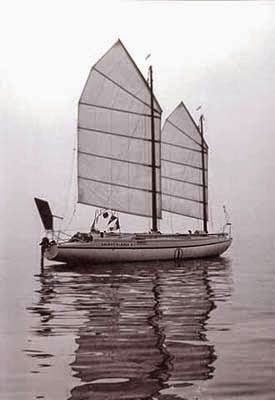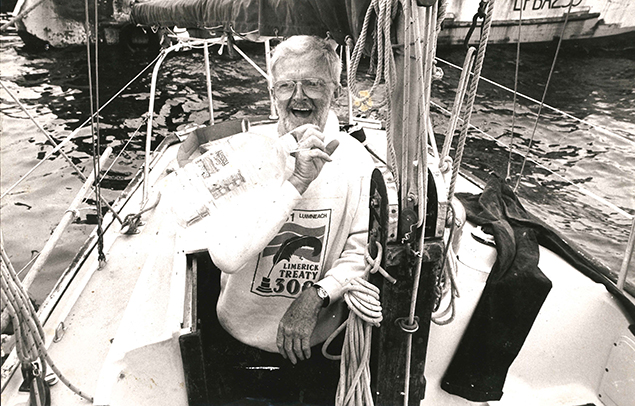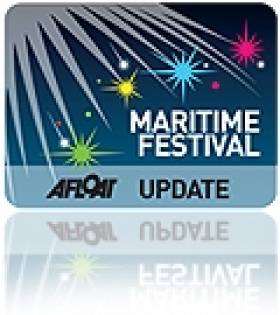Displaying items by tag: Pat Lawless
Pat Lawless Rides out Storm Ellen in Mid-Atlantic
While Ireland is battered by the multiple surges of Storm Ellen, the irrepressible Pat Lawless of Ballyferriter on the Dingle Peninsula is riding it out on the southern fringes of the huge weather system, halfway home from the Azores in his robust Saltram Saga 36.
His boat Iniscealtra is a modern variant on the classic Colin Archer concept, and Pat is building up ocean miles towards participation in the 2022 Golden Globe Race.
The word from the far southwest of Ireland is that he’d been looking for something approaching real Southern Ocean weather in the North Atlantic, and It looks as though the south side of Storm Ellen has obliged. For now, we’re told that all is well on board as the Ballyferriter man rides it out under bare poles aboard Iniscealtra, named after the renowned holy island on Lough Derg.
 Pat Lawless aboard Iniscealtra
Pat Lawless aboard Iniscealtra While the winds halfway between the Azores and Ireland may not be as severe as some of those experienced in Ireland in the last 18 hours, Iniscealtra has still been experiencing full Atlantic gales
While the winds halfway between the Azores and Ireland may not be as severe as some of those experienced in Ireland in the last 18 hours, Iniscealtra has still been experiencing full Atlantic gales
2018 Golden Globe Race Attracted Multiple Millions In Publicity Worldwide
Independent analysis on media coverage during the 2018 Golden Globe Race says the event attracted worldwide coverage worth as much as US$185 million.
Les Sables d’Olonne, which will be the host start and finish port again in 2022, gained two years of international publicity valued at €16.5 million.
And Falmouth — which hosted the pre-race Suhaili 50 Parade of Sail, celebrating the 50th anniversary of Sir Robin Knox-Johnston’s departure in the original 1986 Sunday Times Golden Globe, as well as the start of the SITraN Challenge race to Les Sables d’Olonne — gained £1.85m (US$2.38m) from its three days of events.
Golden Globe Race founder Don McIntyre said today: “What a fantastic, solid result for a unique original adventure created by a small passionate management team with low budgets.
“It confirms the support and huge following the 2018 GGR achieved from ordinary people interested in a simple, back to basics human endeavour. No fluff; just an honest, down-to-earth non-stop solo race around the world that media understand.
“We must also thank the passion of our French fans and our enthusiastic host port and logistics partner Les Sables d'Olonne, Ville and Agglomeration. The GGR family continues to grow, ensuring the 2022 edition will be an even bigger success.”
Yannick Moreau, Mayor of Les Sables d’Olonne and president of the Agglomeration said: “For a first edition, the GGR has been an international success. I am looking forward to the second edition from Les Sables d’Olonne on September 4, 2022.”
With three years to go until the start of the next Golden Globe Race, only one ordinary and five special invitation spots are available with 22 Suhaili Class entrants already paid up — among them 63-year old Pat Lawless from Ballyferriter, Co Kerry.
Pat will be following in the wake of his late father who completed his own circumnavigation of the world in 1996 at the age of 70 — and aims to finish what Gregor McGuckin started in on the 50th anniversary of the original Golden Globe.
Son Of Circumnavigator Pat Lawless Aims For First Irish Non-Stop Voyage In 2022 Golden Globe Race
As the awards day for the 2018 Golden Globe Race is taking place today (Monday 22 April) in Les Sables, applications for invites to join the next Golden Globe Race in 2022 are now open — and one of those hopeful to join the global solo voyagers is Irish fisherman Pat Lawless.
Born in bred in Limerick on the banks of the River Shannon, Pat comes from a solo offshore sailing pedigree as his late father, also named Pat, completed his own circumnavigation of the world (in separate stages) in 1996 at the age of 70 — and since had a river festival named in his honour.
Pat Junior now lives in Ballyferriter, Co Kerry, the most westerly village in Europe, with his wife and two of his four children, and makes furniture for a living.
However, over the last six decades Pat has amassed around 150,000km on the water between sailing and fishing.
Now he aims to finish what Conor McGuckin started in the 50th anniversary of the Golden Globe Race and become the first Irishman to do a non-stop, unassisted solo circumnavigation of the world.
As Pat’s nephew Patrick Stritch explains to Afloat.ie, the boat he’s selected for the task is a Saltram Saga 36.
“Alan Papa designed her as a development of the Colin Archer ‘Redmingskoite’ sailing lifeboat hull, from which for many years have been regarded as being amongst the most sea-worthy around and even substantially faster than the original,” says Patrick.
“They are a mighty fine boat for the Southern Ocean, able to hold on to working sail in strong winds, without healing more than 20 degrees.”
Pat will have the next three years to get to know every aspect of his boat like the back of his hand before the next Golden Globe Race sets off from France on 21 August 2022.
This date commemorates the anniversary of Bernard Moitessier setting off in the original Sunday Times Golden Globe in 1968, and a new one-design class based on his famous yacht Joshua has been added for the next edition.
Enda O'Coineen Will Not Be First Irish Solo Circumnavigator
The current Vendee Globe Race non-stop round the world is deservedly attracting enough attention without having to make over-stated claims on behalf of some of its participants writes W M Nixon.
The official website is today carrying a story that if Enda O’Coineen can succeed in his plan of sailing his dismasted IMOCA 60 Kilcullen Voyager from Dunedin at the south end of New Zealand under jury rig to Auckland 800 miles away to the north, where a loaned replacement masts awaits, then if he can continue the voyage back to les Sables d’Olonne round Cape Horn he will become the first Irishman to sail solo round the world.
Not so. Noted Dublin marine artist Pete Hogan, who sailed solo round the world in his gaff ketch Molly B, said today that the number of misapprehensions about who was first doing what in the Irish circumnavigation stakes is astonishing.
For instance, when he rounded Cape Horn in the 1990s, he was acclaimed as the first Irishman to do it alone, for of course Conor O’Brien had done it with the crewed Saoirse in 1925. Yet Pete Hogan found it very difficult to get anyone to listen when he subsequently tried to set the record by saying that Bill King of Galway with the junk-rigged ketch Galway Blazer was the first solo, and that was way back in 1973.
The fact that Bill King was a distinguished former British submarine commander may have projected the image of being non-Irish. But in fact he flew both the Irish tricolour and the
British red ensign, and his home was Oranmore Castle at the head of Galway Bay.
 Bill King’s purpose-designed Galway Blazer circumnavigated the world solo south of the great Capes in 1973.
Bill King’s purpose-designed Galway Blazer circumnavigated the world solo south of the great Capes in 1973.
Since then, other Irish sailors who have striven to circumnavigate include Declan Mackell, originally from Portaferry but Canadian-based by the time he undertook his voyage in a Contessa 32, with which he returned home to Ireland for a prolonged stay during his circuit.
Another lone circumnavigator, Pat Lawless of Limerick who completed his voyage with a Seadog ketch in 1996 at the age of 70, had hoped to take in Cape Horn, but rigging damage forced him into a Chilean port, and eventually he returned to Ireland via the Panama Canal. But his circuit was definitely completed, and completed alone.
And Pete Hogan believes there may be one or two other Irish lone circumnavigators who have done it without fanfare. For not everyone seeks the kind of publicity which the Vendee Globe inevitably provides.
 Limerick circumnavigator – the irrepressible Pat Lawless aboard his world-girdling Seadog ketch
Limerick circumnavigator – the irrepressible Pat Lawless aboard his world-girdling Seadog ketch
#shannon – A new festival named in honour of a Limerick man who famously completed a solo circumnavigation of the world will take place along the banks of the River Shannon in Limerick City on Sunday June 8th next.
Organised and funded by the Mid West Regional Authority (MWRA) through its participation in a European Programme for developing and promoting the watersports sector in Europe's Atlantic Area, the 'Pat Lawless Sail and Oar Festival' will celebrate Limerick's status as a riverside city and will feature a series of events on the river.
For spectators gathered on either side of the river at Harvey's Quay and Clancy Strand, there will be Rowing and Sailing Regattas, a historic kayak tour of Limerick City and a Gandelow boat demonstration.
The late Pat Lawless made international headlines in 1996 when the then 70-year-old sailed his 30-foot vessel, the Seadog, up the Shannon Estuary on the final leg of his 30,000-mile around the world voyage. Mr. Lawless, who was from the South Circular Road and was a member of the Iniscealtra Sailing Club in Mountshannon, passed away in 2010.
Majella O'Brien, EU Projects Officer with the MWRA explained that the upcoming festival is part of its ongoing efforts through the NEA2 project to develop and promote the watersports sector in the Mid West Region.
"Lough Derg, the River Shannon and the Estuary are intrinsically linked with the economic and social history of this region. The potential of these waterways for tourism development remains underexplored however. By hosting the 'Pat Lawless Sail and Oar Festival" we want to demonstrate this potential to our European project partners," she said.
Ms. O'Brien continued: "Through our participation in the NEA2 programme and by working in conjunction with other regional development agencies, the MWRA will continue to look for new ways that this region can build on existing marine leisure initiatives to help inform and develop new opportunities for sustainable development of water sports on our rivers, lakes and coastline. In doing so, we could attract thousands of additional visitors to the Mid West Region each year."
"We are particularly delighted to be able to host a river festival in honour of Pat Lawless whose crossings of the Atlantic Ocean and solo circumnavigation of the world brought great pride to Limerick and the wider region," she concluded.
The 'Pat Lawless Sail and Oar Festival' takes place in Limerick City on Sunday June 8th next.

































































